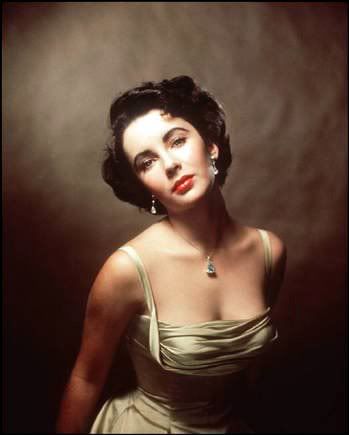 |
biography on Elizabeth Taylor. It is somewhat
cropped on the book cover.
The original (above) is by Philippe Halsman, taken
for LIFE magazine in 1948.
Halsman has a black and white version, with
a more subdued pose, at the MoMA.
-------------------------------------------------------------------------
I found another gem of a book, a hardback How to be a Movie Star: Elizabeth Taylor in Hollywood, at a regular bookstore, down to $6.99 from $28. I'm not really surprised at the reduction, since it is a "celebrity" biography. People would rather pick up the glitzy, photo-filled glamor magazines, rather than read through four hundred pages of writing (albeit many anecdotal and quick reads) with only a few pages of photographs. And there have been quite a few commemorative magazine issues on Elizabeth Taylor this past month. There's a 100-page special American Media collector's issue in March which is going for $5.99. Even People Magazine is publishing a 128-page "soft-cover book": Elizabeth Taylor, 1932-2011 for $11.99.
The author of How to be a Movie Star: Elizabeth Taylor in Hollywood, William J. Mann, has previously written about another screen legend, Katherine Hepburn. But much of the rest of his work is on "gays and lesbians" including one titled: Behind the Screen: How Gays and Lesbians Shaped Hollywood. Now, that idea itself is up for contention. It is the same with the fashion world, where the "understood" insider report is that it is homosexuals who "shaped" the fashion world. Much is also said about the art world and its non-conventional artists - for example, people have been trying to pin the "homosexual" label on Leonardo da Vinci, but there is no evidence for that.
Of course, homosexuals have always had a place in the Western civilization (perhaps following the more explicit Ancient Greece?), but no culture, until our brave new world, has put them on such a pedestal. It is a little off-putting that this really very good book is seen through the prism of a homosexual's lens. It is a little like what I felt on reading the "leftist-liberal" John Leonard's book on New York, which I wrote about here. Still, talent is talent, as I wrote on John Leonard, and How to be a Movie Star is a clever and insightful book. For all his apparent adulation, Mann takes Elizabeth seriously, and indicates that she was as smart as she was beautiful, and orchestrated many of the events of her life, mostly through sheer hard work and persistence.
This is what Mann observes in the prologue:
Elizabeth Taylor had...tangled with lots [of sharks]: demanding studio heads, overbearing directors, bluenose columnists, greedy husbands. And she's done so with a shrewdness and a keen understanding of just how a star went about getting what she wanted. "She was always in control," said a friend, photographer Giannin Bozzachi. "She did not seek fame but she knew how to use it. She was very smart. People don't know how smart." Some chroniclers, perhaps too dazzled by the violet eyes and the glittery melodrama of her life, have missed that salient point. Long before our own celebrity age, Elizabeth Taylor carved the template for how to be a movie star. So many of the tricks of the trade can be traced right back to her.